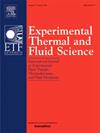An experimental study on thermoacoustic instabilities of non-premixed combustion using internal flue gas recirculation
IF 2.8
2区 工程技术
Q2 ENGINEERING, MECHANICAL
Experimental Thermal and Fluid Science
Pub Date : 2024-11-30
DOI:10.1016/j.expthermflusci.2024.111365
引用次数: 0
Abstract
Internal flue gas recirculation (IFGR) is a commonly used low-NOx combustion technique in industrial boilers. This study experimentally investigated the nonlinear behavior of the self-excited thermoacoustic instability in non-premixed combustion using IFGR. CH* chemiluminescence imaging and Proper orthogonal decomposition (POD) analysis were conducted to study the characteristics of flame dynamics. The results showed that, as global equivalence ratio decreased, the combustion system sequentially exhibited combustion noise, 90 Hz limit cycle oscillation, dual-frequency transition, and 80 Hz limit cycle oscillation, accompanied by frequency shift and mode transition phenomena. For the 90 Hz and 80 Hz oscillation modes, the first mode of POD exhibited axial oscillation patterns and global flashing oscillation patterns, respectively. Finally, combustion chamber temperature measurement and low-order thermoacoustic network model was used to analyze the mechanisms behind mode transition and frequency shift phenomena. The results showed that the decrease in combustion chamber temperature, which was caused by decrease, led to a reduction in the frequency of the first natural acoustic mode, ultimately resulting in the mode transition. IFGR altered the range of where thermoacoustic oscillations occur. The phenomenon of frequency shift was primarily caused by the decrease in convective time delay . This study further explores the influence of IFGR and on thermoacoustic oscillation modes and flame dynamics, which contributes to the development of stable, low-NOx non-premixed combustors.
烟气内循环非预混燃烧热声不稳定性实验研究
烟气内部再循环(IFGR)是工业锅炉中常用的低nox燃烧技术。本文利用IFGR对非预混燃烧中自激热声不稳定性的非线性行为进行了实验研究。通过CH*化学发光成像和适当正交分解(POD)分析研究了火焰动力学特性。结果表明:随着等效比φg的减小,燃烧系统依次表现为燃烧噪声、90 Hz极限环振荡、双频过渡和80 Hz极限环振荡,并伴有频移和模态转变现象;在90 Hz和80 Hz振荡模态下,POD的第一模态分别表现为轴向振荡型和全局闪烁振荡型。最后,利用燃烧室温度测量和低阶热声网络模型分析了模式转换和频移现象的机理。结果表明:φg减小导致燃烧室温度降低,导致第一自然声模态频率降低,最终导致模态跃迁;IFGR改变了发生热声振荡的φg范围。频移现象主要是由对流时延τconv的减小引起的。本研究进一步探讨了IFGR和φg对热声振荡模式和火焰动力学的影响,为开发稳定的低nox非预混燃烧室提供了依据。
本文章由计算机程序翻译,如有差异,请以英文原文为准。
求助全文
约1分钟内获得全文
求助全文
来源期刊

Experimental Thermal and Fluid Science
工程技术-工程:机械
CiteScore
6.70
自引率
3.10%
发文量
159
审稿时长
34 days
期刊介绍:
Experimental Thermal and Fluid Science provides a forum for research emphasizing experimental work that enhances fundamental understanding of heat transfer, thermodynamics, and fluid mechanics. In addition to the principal areas of research, the journal covers research results in related fields, including combined heat and mass transfer, flows with phase transition, micro- and nano-scale systems, multiphase flow, combustion, radiative transfer, porous media, cryogenics, turbulence, and novel experimental techniques.
 求助内容:
求助内容: 应助结果提醒方式:
应助结果提醒方式:


